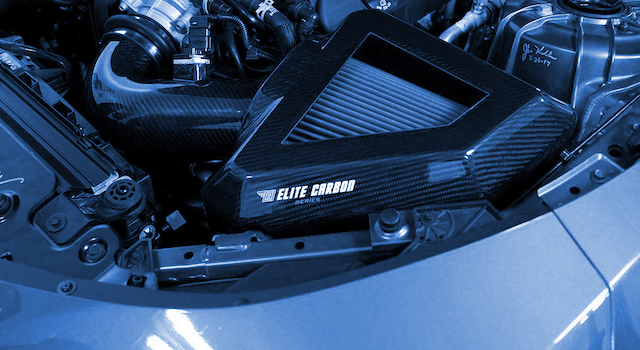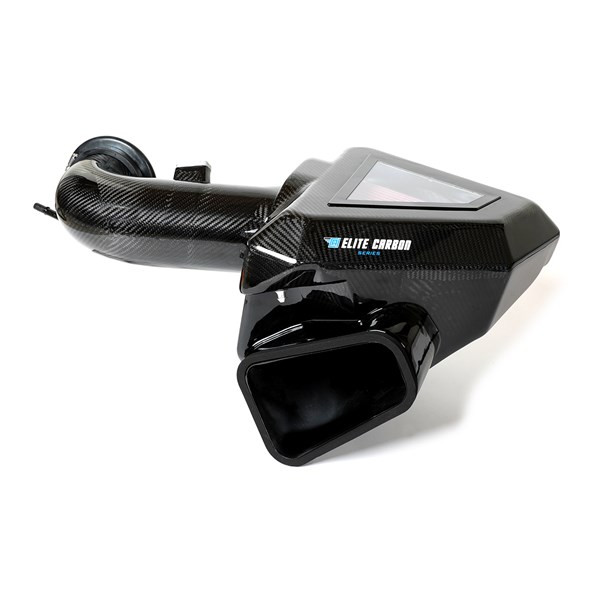Upgrade Your Camaro Stock Intake With An Elite Carbon Cold Air Intake From CAI
If you’re a fan of fast cars and big horsepower, you’ve probably considered swapping out your stock air intake system. Dyno tests show that installing a cold air intake system can boost horsepower, giving you more performance and a better intake sound.
The improved airflow to your engine can also benefit fuel economy. So why wait? You can install the ZL1 Elite Carbon Series yourself, and enjoy enhanced performance in minutes.
ZL1 Elite Carbon Series Intake System

The Elite Carbon Series is our flagship cold air intake. It is constructed almost completely out of carbon fiber. It includes:
- Carbon Fiber Air Box with Clear Inspection Window
- Carbon Fiber Intake Tube + High Performance Air Filter
- Flex Coupler/Stainless Clamps
- Comprehensive Installation Instructions
The ZL1 Elite Carbon Series system uses carbon fiber construction. Benefits include light weight, strength, durability, and heat dissipation properties. The intake tube boasts a sleek design, and the air filter box includes a clear plexiglass window. This allows you to check the filter’s condition to know when it needs cleaning or replacing.
Stainless steel clamps ensure the system remains securely attached. While a flexible coupler facilitates easy connection to the throttle body. Additionally, it comes equipped with a high-performance air filter. This kit is compatible with the 2017-2021 Camaro ZL1. Check out our range of Elite Series cold air induction kits, too.
The Installation Process
Replacing an air intake system may seem scary if you don’t work on your car. But it’s quite straightforward, particularly with this kit. It includes all the necessary components and an excellent installation guide to help you along the way. Watch the video below to see how simple the process can be:
- Start by loosening the clamps and screws on your current air intake system. Carefully remove the mass air flow (MAF) sensor and detach the PCV tube. Once everything is disconnected, remove the entire assembly from the car.
- Next, begin the assembly process, which is straightforward. Connect the carbon fiber intake tube to the high-performance filter by screwing them together. Place the air filter inside the filter housing box and secure it. Wrap the foam gasket around the lower intake of the filter box.
- Attach the coupler boot to the throttle body tube, making sure to follow the directions indicated for proper orientation. Then, fit the intake tube into the other end of the coupler boot. It’s best to connect the intake tube side first, then pivot the air filter box into its final position.
- Secure the system by tightening the stainless-steel clamps around the coupler boot first to ensure a tight fit. Attach the air filter body to the car using the retainer clips that fit into the grommets on your vehicle.
- Lastly, reconnect the PCV tube and carefully reinsert the MAF sensor into its slot on the intake tube. As demonstrated in the video, it might be a snug fit, so proceed slowly to avoid any damage.
Cold Air Inductions Has The Perfect Kit For Your Camaro
It’s that simple to upgrade your Camaro’s performance and intake sound and enhance its fuel efficiency. As the video shows, installing our cold air intake system is easy. Every kit includes detailed instructions that are easy to follow. If you prefer a visual guide to the installation process, watch the video above.
Upgrading to a CAI Cold Air Intake is quick and easy, thanks to our custom-designed products. And simple installation procedure. Our intakes are made to last, and the reusable air filter element will save you money over a stock system.
We develop cold air intakes for specific vehicles and test our systems in real-world conditions to deliver results you can feel and hear.
Cold Air Inductions has been a leading manufacturer of sealed air box intake systems since 2004. We offer a lifetime warranty. Check out our range of high-quality intakes here. Then contact our team to order the cold air induction kit that sounds as good as it performs.


